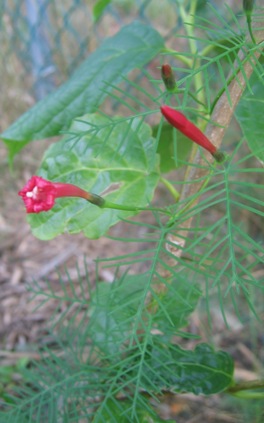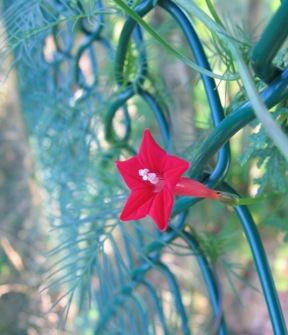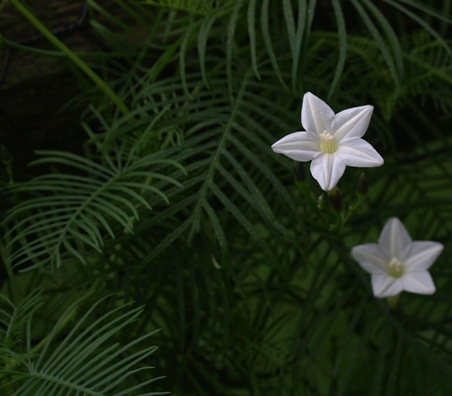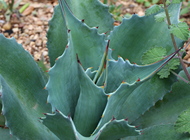 |
Ipomoea quamoclit |
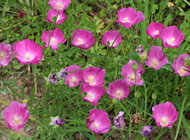 |
| Synonym(s) |
Quamoclit pennata |
| Common name |
cypress vine |
| Family |
convolvulaceae |
| Life cycle |
annual vine |
| Flowers |
red |
| Light |
sun |
From seed  |
germinate at room temperature or slightly warmer; scarification is helpful
detailed seed-starting info below
|
I've never had much luck with cypress vines started indoors from seed: they grow just fine indoors, and survive hardening off outdoors. But after I plant them out, they usually just kind of fade away. Out of sight, out of mind: I don't know what actually becomes of them, but they sure don't get to blooming stage. The first time I successfully grew these vines was when I planted some seeds directly into the soil in early June. Lo – lacy-frilly-foliaged plants emerged about a month later. It wasn't until late August that the first flowers showed up (scarlet, as I was led to expect), but it was worth it. After several more unsuccessful indoor seeding attempts, I received a few seedlings in late June from a fellow gardener, and planted them along a stretch of split rail fence. July turned out to be brutally dry and hot, while August and September brought record rainfall. As a result, I neglected my gardening duties for most of summer. Then suddenly, in late September, I noticed the vines, which had now climbed up to the top of the fence, and were blooming – white! That was a big surprise. Too bad it's so late in the season: I don't think they will set viable seed. But I think I've found the secret to growing these annuals successfully: wait until warm weather has firmly taken hold before setting them outside. So I'll try them again – and expect to be surprised by the flowers when they finally arrive.
|
In our garden, this plant grows in the following area: back fence border About my plant portraits
PlantLinks to other web pages about Ipomoea quamoclit
Some particularly helpful links to other websites
Visitors to this page have left the following comments| Anthony I | Jun 29, 2006 | I bought these seeds this year from a catolog. They recommend soaking them for 24hrs then direct planting them two weeks after last frost. I forgot about them and ended up direct planting (after soaking) them around mid-late june. They came up in about a week. Of course it did rain for four days after I planted them. I don't know if that helped or not. There still small so I'm worried they won't have time to bloom. Just have to wait I guess. I think soaking is the key though. After soaking, the seeds were already starting to open up. |
| Aaleigha | Jan 29, 2009 | I love Ipomea in all it's forms. I've had almost 100% germination with every one I've tried, doing nothing more than soaking overnight. By the way, I love your' site. Wish I had found it a long time ago. Going to try the baggy method tonight. |
| Chris Orr | Apr 21, 2009 | I started some of these a couple weeks ago and have had great success so far. I put 2 seeds per cup in 5 peat cups and now I have 9 little cypress vine seedlings and I'm not sure what to do with all of them. I'm wondering how well they actually climb. Can they climb brick or does it need to be a fence-like structure or trellis? Also, how well do they do in hanging pots? any info you might be able to provide would be quite appreciated.
Cypress vine climbs by twirling around - so it won't do well on a wall unless you provide a trellis. Don't set them out till the weather is reliably warm - perhaps by mid-May (going by Pennsylvania experience here). I haven't tried them in hanging pots - that's an interesting idea! |
| M.L. Fromme | May 05, 2009 | ONce this gets started and the seed pods drop off, you have them coming up next year by the thousands. Here in South Texas a lot of my friends have gotten rid of the plants as it is so evasive. But I still like mine, just heck to clean off the fence when it has frozen and turned brown. Mine goes up a chain link fence and yes it is really clingy, tough tendrils.
I wish mine would self-seed - but our season seems to be too short for the plants to set viable seed. Trying again this year, from traded seed. |
| Jan Rubelmann | Aug 21, 2009 | I got mine from my cousin who lives in Evansville, Indiana and she always plants them or they self seed in a big flower pot an climbs her car port post which is like a trellis. I was just there and it is to the roof of the carport and blooming very nice. Already forming seed which she takes and keeps in the fridge. So I plant mine in a flower pot with a trellis provided and they do well also. I need a wider trellis next year. Mine also self seeded but I did add a few more seeds to the pot. I put the pot on the porch over winter. I just gave a freind in MN some seeds and hers are doing well also. None of us ever soaked the seeds. Good luck next year. |
| isabel mcgill | Feb 07, 2010 | Today I picked my favorite flower called Cypress Vine I got it from Lowes the colores of the Cypress Vine were red,pink,white. |
- Seed from '02 trade. Baggy 75F (30%G, 2-3d)
- Same seed as above. Lightly sandpapered, baggy 75F (100%G, 2-3d)
June 4: direct-sowed 6 seeds, after scarifying by rubbing on concrete paver; 2G in late June
- 6/25: direct-sowed 22 seeds (unscarified); about half germinated 2-3 weeks later
- Seed from '02 trade. Scarified with sandpaper, soak 1d. Baggy 75F (100%G, 1-3d)
- Seed from '07 trade. Scarified with sandpaper, baggy 75F (100%G, 1-7d)
- Same seed as above. Sandpapered, baggy 75F (84%G, 3d)
- Same seed as above. Sandpapered, baggy 75F (72%G, 2-5d)
- Seed from NARGS '18/'19 exchange. Sandpapered, baggy 70F (43%G, 6-19d)
- Same seed as above. Sandpapered, baggy 70F (42%G, 2-42d). Turned out to be something different, probably I. hederifolia.
- Seed from NARGS '21/'22 exchange. Direct to pot out (a few SL, several weeks)
- Same seed as above. Sandpapered, baggy 70F (100%G, 6d)
- Same seed as above. Sandpapered, baggy 70F (100%G, 4-6d)
Seed from '24 garden. Sandpapered, baggy 70F (80%G, required further sandpaper treatment and exposure to warmer temperatures)
Sensitive to cold temperatures (even above freezing) as seedlings.
I welcome comments about my web pages; feel free to use the form below to
leave feedback about this particular page. For the benefit of other visitors
to these pages, I will list any relevant comments you leave, and if
appropriate, I will update my page to correct mis-information. Faced with an
ever-increasing onslaught of spam, I'm forced to discard any comments including
html markups. Please submit your comment as plain text. If you have a
comment about the website as a whole, please leave it in my
guestbook. If you
have a question that needs a personal response, please
e-mail me.
Last modified:
April 10, 2025
Contact me
|


